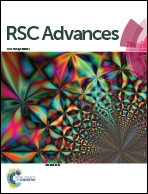Preparation and preliminary application of 5-HMF@SiO2 micro-particles†
Abstract
A new approach for the surficial-modification of silica with 5-HMF as a functional molecule was first designed. The infrared spectrum, X-ray photoelectron spectroscopy and elemental analysis showed that the modified-SiO2 particles were successfully established. Full dispersion of SiO2 and the introduction of gallic acid were confirmed to be favorable for the 5-HMF content. The retention behavior of bovine serum albumin on the modified-SiO2 particle suggested that the novel particles could serve as a promising stationary phase on the identification of the particular proteins.


 Please wait while we load your content...
Please wait while we load your content...